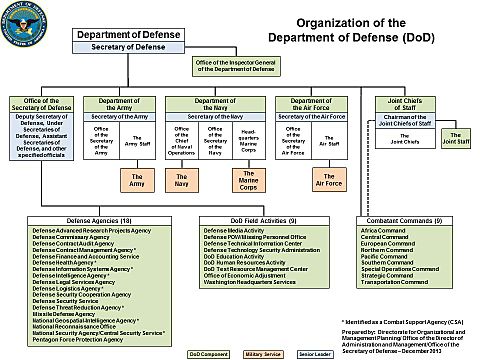United States Secretary of Defense facts for kids
Quick facts for kids United States Secretary of Defense |
|
|---|---|

Flag of the secretary
|
|

Seal of the department
|
|
| United States Department of Defense Office of the Secretary of Defense |
|
| Style | Mr. Secretary (informal) The Honorable (formal) |
| Abbreviation | SecDef |
| Member of | Cabinet National Security Council |
| Reports to | President of the United States |
| Seat | The Pentagon, Arlington County, Virginia |
| Appointer | The President
with Senate advice and consent
|
| Term length | No fixed term |
| Constituting instrument | 10 U.S.C. § 113 |
| Precursor | Secretary of War Secretary of the Navy |
| Formation | September 17, 1947 |
| First holder | James Forrestal |
| Succession | Sixth |
| Deputy | Deputy Secretary of Defense |
| Salary | Executive Schedule, level I |
The United States Secretary of Defense (acronym: SecDef) is the head of the United States Department of Defense (DoD), the executive department of the U.S. Armed Forces, and is a high-ranking member of the federal cabinet. The secretary of defense's position of command and authority over the military is second only to that of the president of the United States, who is the commander-in-chief. This position corresponds to what is generally known as a defense minister in many other countries. The president appoints the secretary of defense with the advice and consent of the Senate, and is by custom a member of the Cabinet and by law a member of the National Security Council.
To ensure civilian control of the military, U.S. law provides that the secretary of defense cannot have served as an active-duty commissioned officer in the military in the preceding seven years except for generals and admirals, who cannot have served on active duty within the previous ten years. Congress can legislatively waive this restriction and has done so three times, for George C. Marshall, James N. Mattis, and Lloyd J. Austin III.
Subject only to the orders of the president, the secretary of defense is in the chain of command and exercises command and control, for both operational and administrative purposes, over all DoD-administered service branches – the Army, Marine Corps, Navy, Air Force, and Space Force – as well as the Coast Guard when its command and control is transferred to the Department of Defense. Only the secretary of defense (or the president or Congress) can authorize the transfer of operational control of forces between the three military departments (Department of the Army, the Navy, and the Air Force) and the eleven Unified Combatant Commands. Because the secretary of defense is vested with legal powers that exceed those of any commissioned officer, and is second only to the president in the military hierarchy, its incumbent has sometimes unofficially been referred to as "deputy commander-in-chief". The chairman of the Joint Chiefs of Staff is the principal military adviser to the secretary of defense and the president; while the chairman may assist the secretary and president in their command functions, the chairman is not in the chain of command.
The secretary of state, the secretary of the treasury, the secretary of defense, and the attorney general are generally regarded as the four most important (and are officially the four most senior and oldest) cabinet officials because of the size and importance of their respective departments.
The current Secretary of Defense is Pete Hegseth.
Contents
History
An Army, Navy, and Marine Corps were established in 1775, in concurrence with the American Revolution. The War Department, headed by the secretary of war, was created by Act of Congress in 1789 and was responsible for both the Army and Navy until the founding of a separate Department of the Navy in 1798.

Based on the experiences of World War II, proposals were soon made on how to more effectively manage the large combined military establishment. The Army generally favored centralization while the Navy had institutional preferences for decentralization and the status quo. The resulting National Security Act of 1947 was largely a compromise between these divergent viewpoints. It renamed the Department of War the Department of the Army, and added both it and the Department of the Navy to a newly established National Military Establishment (NME). The Act also separated the Army Air Forces from the Army to become its own branch of service, the United States Air Force.
A new title was coined by the Act for the head of the NME: Secretary of Defense. At first, each of the service secretaries maintained cabinet status. The first secretary of defense, James Forrestal, who in his previous capacity as the secretary of the Navy had opposed the creation of the new position, found it difficult to exercise authority over the other branches with the limited powers his office had at the time. To address this and other problems, the National Security Act was amended in 1949 to further consolidate the national defense structure in order to reduce interservice rivalry, directly subordinate the secretaries of the Army, the Navy and the Air Force to the secretary of defense in the chain of command, and rename the National Military Establishment as the Department of Defense, making it one Executive Department. The position of the deputy secretary of defense, the number two position in the department, was also created at this time.
The general trend since 1949 has been to further centralize management in the Department of Defense, elevating the status and authorities of civilian OSD appointees and defense-wide organizations at the expense of the military departments and the services within them. The last major revision of the statutory framework concerning the position was done in the Goldwater–Nichols Department of Defense Reorganization Act of 1986. In particular, it elevated the status of joint service for commissioned officers, making it in practice a requirement before appointments to general officer and flag officer grades could be made.
As the secretary of defense is a civilian position intended to be independent of the active-duty leadership, a secretary is required to have been retired from service for at least seven (originally ten) years unless a waiver is approved by Congress. Since the creation of the position in 1947, such a waiver has been approved only three times, for Army general George Marshall in 1950, Marine Corps General Jim Mattis in 2017, and retired Army general Lloyd Austin in 2021.
Powers and functions
The secretary of defense, appointed by the president with the advice and consent of the Senate, is by federal law (10 U.S.C. § 113) the head of the Department of Defense, "the principal assistant to the President in all matters relating to Department of Defense", and has "authority, direction and control over the Department of Defense". Because the Constitution vests all military authority in Congress and the president, the statutory authority of the secretary of defense is derived from their constitutional authorities. Since it is impractical for either Congress or the president to participate in every piece of Department of Defense affairs, the secretary of defense and the secretary's subordinate officials generally exercise military authority.
As the head of DoD, all officials, employees and service members are "under" the secretary of defense. Some of those high-ranking officials, civil and military (outside of OSD and the Joint Staff) are: the secretary of the Army, secretary of the Navy, and secretary of the Air Force, Army chief of staff, commandant of the Marine Corps, chief of naval operations, Air Force chief of staff, chief of space operations, and chief of the National Guard Bureau and the combatant commanders of the Combatant Commands. All these high-ranking positions, civil and military, require Senate confirmation.
The Department of Defense is composed of the Office of the Secretary of Defense (OSD), the Joint Chiefs of Staff (JCS) and the Joint Staff (JS), Office of the Inspector General (DODIG), the Combatant Commands, the Military Departments (Department of the Army (DA), Department of the Navy (DON) & Department of the Air Force (DAF)), the Defense Agencies and DoD Field Activities, the National Guard Bureau (NGB), and such other offices, agencies, activities, organizations, and commands established or designated by law, or by the president or by the secretary of defense.
Department of Defense Directive 5100.01 describes the organizational relationships within the department and is the foundational issuance for delineating the major functions of the department. The latest version, signed by former secretary of defense Robert Gates in December 2010, is the first major re-write since 1987.
Office of the Secretary of Defense
The secretary's principally civilian staff element is called the Office of the Secretary of Defense (OSD) and is composed of the deputy secretary of defense (DEPSECDEF) and six under secretaries of defense in the fields of acquisition & sustainment, research & engineering, comptroller/chief financial officer, intelligence, personnel & readiness, and policy; several assistant secretaries of defense; other directors and the staffs under them.
The name of the principally military staff organization, organized under the chairman of the Joint Chiefs of Staff, is the Joint Staff (JS).
Awards and decorations
The Defense Distinguished Service Medal (DDSM), the Defense Superior Service Medal (DSSM), the Defense Meritorious Service Medal (DMSM), the Joint Service Commendation Medal (JSCM) and the Joint Service Achievement Medal (JSAM) are awarded, to military personnel for service in joint duty assignments, in the name of the secretary of defense. In addition, there is the Joint Meritorious Unit Award (JMUA), which is the only ribbon (as in non-medal) and unit award issued to joint DoD activities, also issued in the name of the secretary of defense.
The DDSM is analogous to the distinguished services medals issued by the military departments (i.e. Army Distinguished Service Medal, Navy Distinguished Service Medal & Air Force Distinguished Service Medal), the DSSM corresponds to the Legion of Merit, the DMSM to the Meritorious Service Medal, the JSCM to the service commendation medals, and the JSAM to the achievement medals issued by the services. While the approval authority for DSSM, DMSM, JSCM, JSAM and JMUA is delegated to inferior DoD officials: the DDSM can be awarded only by the secretary of defense.
Recommendations for the Medal of Honor (MOH), formally endorsed in writing by the secretary of the military department concerned and the chairman of the Joint Chiefs of Staff, are processed through the under secretary of defense for personnel and readiness, and such recommendations be must approved by the secretary of defense before it can be handed over to the president, who is the final approval authority for the MOH, although it is awarded in the name of Congress.
The secretary of defense, with the concurrence of the secretary of state, is the approval authority for the acceptance and wear of NATO medals issued by the secretary general of NATO and offered to the U.S. permanent representative to NATO in recognition of U.S. servicemembers who meet the eligibility criteria specified by NATO.
Congressional committees
As the head of the department, the secretary of defense is the chief witness for the congressional committees with oversight responsibilities over the Department of Defense. The most important committees, with respect to the entire department, are the two authorizing committees, the Senate Armed Services Committee (SASC) and the House Armed Services Committee (HASC), and the two appropriations committees, the Senate Appropriations Committee and the House Appropriations Committee.
For the DoD intelligence programs the Senate Select Committee on Intelligence and the House Permanent Select Committee on Intelligence have the principal oversight role.
National Security Council
The secretary of defense is a statutory member of the National Security Council. As one of the principals, the secretary along with the vice president, secretary of state and the assistant to the president for national security affairs participates in biweekly Principals Committee (PC) meetings, preparing and coordinating issues before they are brought before full NSC sessions chaired by the president.
Role in the military justice system
The secretary is one of only five or six civilians – the others being the president, the three "service secretaries" (the secretary of the Army, secretary of the Navy, and secretary of the Air Force), and the secretary of homeland security (when the United States Coast Guard is under the United States Department of Homeland Security and has not been transferred to the Department of the Navy under the Department of Defense) – authorized to act as convening authority in the military justice system for General Courts-Martial (10 U.S.C. § 822: article 22, UCMJ), Special Courts-Martial (10 U.S.C. § 823: article 23, UCMJ), and Summary Courts-Martial (10 U.S.C. § 824: article 24 UCMJ).
Salary
The Secretary of Defense is a Level I position in the Executive Schedule, thus earning a salary of US$246,400, as of October 2024.
List of secretaries of defense
The longest-serving secretary of defense is Robert McNamara, who served for a total of 7 years, 39 days. Combining his two non-sequential services as the secretary of defense, the second-longest serving is Donald Rumsfeld, who served just ten days fewer than McNamara. The second-longest unbroken tenure was Caspar Weinberger's, at 6 years, 306 days.
The shortest-serving secretary of defense is Elliot Richardson, who served 114 days and then was appointed U.S. attorney general amid the resignations of the Watergate Scandal. (This is not counting deputy secretaries of defense William P. Clements and William Howard Taft IV, who each served a few weeks as temporary/acting secretary of defense).
For precursors to this position prior to the establishment of the Department of Defense, see the lists of secretaries of the Navy and secretaries of war prior to 1947.
- Parties
Democratic Republican Independent / Unknown
- Status
Denotes an Acting Secretary of Defense
| No. | Image | Name | Start | End | Duration | Party | Home State | President(s) | ||
|---|---|---|---|---|---|---|---|---|---|---|
| 1 |  |
James Forrestal | September 17, 1947 | March 28, 1949 | 1 year, 192 days | Democratic | New York | Harry S. Truman (1945–1953) |
||
| 2 |  |
Louis A. Johnson | March 28, 1949 | September 19, 1950 | 1 year, 175 days | Democratic | West Virginia | |||
| 3 |  |
George C. Marshall | September 21, 1950 | September 12, 1951 | 356 days | Independent | Pennsylvania | |||
| 4 |  |
Robert A. Lovett | September 17, 1951 | January 20, 1953 | 1 year, 125 days | Republican | New York | |||
| 5 |  |
Charles Erwin Wilson | January 28, 1953 | October 8, 1957 | 4 years, 253 days | Republican | Michigan | Dwight D. Eisenhower (1953–1961) |
||
| 6 |  |
Neil H. McElroy | October 9, 1957 | December 1, 1959 | 2 years, 53 days | Republican | Ohio | |||
| 7 |  |
Thomas S. Gates Jr. | December 2, 1959 | January 20, 1961 | 1 year, 49 days | Republican | Pennsylvania | |||
| 8 |  |
Robert McNamara | January 21, 1961 | February 29, 1968 | 7 years, 39 days | Republican | Michigan | John F. Kennedy (1961–1963) Lyndon B. Johnson (1963–1969) |
||
| 9 |  |
Clark Clifford | March 1, 1968 | January 20, 1969 | 325 days | Democratic | Maryland | Lyndon B. Johnson (1963–1969) |
||
| 10 |  |
Melvin Laird | January 22, 1969 | January 29, 1973 | 4 years, 7 days | Republican | Wisconsin | Richard Nixon (1969–1974) |
||
| 11 |  |
Elliot Richardson | January 30, 1973 | May 24, 1973 | 114 days | Republican | Massachusetts | |||
| – |  |
Bill Clements Acting |
May 24, 1973 | July 2, 1973 | 39 days | Republican | Texas | |||
| 12 |  |
James R. Schlesinger | July 2, 1973 | November 19, 1975 | 2 years, 140 days | Republican | Virginia | Richard Nixon (1969–1974) Gerald Ford (1974–1977) |
||
| 13 |  |
Donald Rumsfeld | November 20, 1975 | January 20, 1977 | 1 year, 61 days | Republican | Illinois | Gerald Ford (1974–1977) |
||
| 14 |  |
Harold Brown | January 20, 1977 | January 20, 1981 | 4 years, 0 days | Democratic | California | Jimmy Carter (1977–1981) |
||
| 15 |  |
Caspar Weinberger | January 21, 1981 | November 23, 1987 | 6 years, 306 days | Republican | California | Ronald Reagan (1981–1989) |
||
| 16 |  |
Frank Carlucci | November 23, 1987 | January 20, 1989 | 1 year, 58 days | Republican | Virginia | |||
| – |  |
William Howard Taft IV Acting |
January 20, 1989 | March 21, 1989 | 60 days | Republican | Ohio | George H. W. Bush (1989–1993) |
||
| 17 |  |
Dick Cheney | March 21, 1989 | January 20, 1993 | 3 years, 305 days | Republican | Wyoming | |||
| 18 |  |
Les Aspin | January 20, 1993 | February 3, 1994 | 1 year, 14 days | Democratic | Wisconsin | Bill Clinton (1993–2001) |
||
| 19 |  |
William Perry | February 3, 1994 | January 24, 1997 | 2 years, 356 days | Democratic | Pennsylvania | |||
| 20 |  |
William Cohen | January 24, 1997 | January 20, 2001 | 3 years, 362 days | Republican | Maine | |||
| 21 |  |
Donald Rumsfeld | January 20, 2001 | December 18, 2006 | 5 years, 332 days (7 years, 29 days total) |
Republican | Illinois | George W. Bush (2001–2009) |
||
| 22 |  |
Robert Gates | December 18, 2006 | June 30, 2011 | 4 years, 194 days | Republican | Texas | George W. Bush (2001–2009) Barack Obama (2009–2017) |
||
| 23 |  |
Leon Panetta | July 1, 2011 | February 26, 2013 | 1 year, 240 days | Democratic | California | Barack Obama (2009–2017) |
||
| 24 |  |
Chuck Hagel | February 27, 2013 | February 17, 2015 | 1 year, 355 days | Republican | Nebraska | |||
| 25 |  |
Ash Carter | February 17, 2015 | January 20, 2017 | 1 year, 338 days | Democratic | Massachusetts | |||
| 26 |  |
Jim Mattis | January 20, 2017 | January 1, 2019 | 1 year, 345 days | Independent | Washington | Donald Trump (2017–2021) |
||
| – |  |
Patrick M. Shanahan Acting |
January 1, 2019 | June 23, 2019 | 173 days | Independent | Washington | |||
| – |  |
Mark Esper Acting |
June 24, 2019 | July 15, 2019 | 21 days | Republican | Virginia | |||
| – |  |
Richard V. Spencer Acting |
July 15, 2019 | July 23, 2019 | 8 days | Republican | Wyoming | |||
| 27 |  |
Mark Esper | July 23, 2019 | November 9, 2020 | 1 year, 109 days | Republican | Virginia | |||
| – |  |
Christopher C. Miller Acting |
November 9, 2020 | January 20, 2021 | 72 days | Republican | Iowa | |||
| – |  |
David Norquist Acting |
January 20, 2021 | January 22, 2021 | 2 days | Republican | Massachusetts | Joe Biden (2021–2025) |
||
| 28 |  |
Lloyd Austin | January 22, 2021 | January 20, 2025 | 3 years, 364 days | Independent | Georgia | |||
| – |  |
Robert G. Salesses Acting |
January 20, 2025 | January 25, 2025 | 5 days | Independent | Donald Trump (2025–present) |
|||
| 29 |  |
Pete Hegseth | January 25, 2025 | Incumbent | 91 days | Republican | Tennessee | |||
Succession
Presidential succession
The secretary of defense is sixth in the presidential line of succession, following the secretary of the treasury and preceding the attorney general.
Secretary succession
On December 10, 2020, President Donald Trump modified the order of succession for the office of Secretary of Defense in Executive Order 13963. The order of succession is:
| # | Office |
|---|---|
| 1 | Deputy Secretary of Defense |
| 2* | Secretary of the Army Secretary of the Navy Secretary of the Air Force |
| 3 | Under Secretary of Defense for Policy |
| 4 | Under Secretary of Defense for Intelligence and Security |
| - | Chief Management Officer of the Department of Defense** |
| 5 | Under Secretary of Defense for Acquisition and Sustainment |
| 6 | Under Secretary of Defense for Research and Engineering |
| 7 | Under Secretary of Defense (Comptroller) |
| 8 | Under Secretary of Defense for Personnel and Readiness |
| 9 | Deputy Under Secretary of Defense for Policy |
| 10 | Deputy Under Secretary of Defense for Intelligence and Security; |
| 11 | Deputy Under Secretary of Defense for Acquisition and Sustainment; |
| 12 | Deputy Under Secretary of Defense for Research and Engineering |
| 13 | Deputy Under Secretary of Defense (Comptroller) |
| 14 | Deputy Under Secretary of Defense for Personnel and Readiness |
| 15* | General Counsel of the Department of Defense Assistant Secretaries of Defense Director of Cost Assessment and Program Evaluation Director of Operational Test and Evaluation Chief Information Officer of the Department of Defense |
| 16* | Under Secretary of the Army Under Secretary of the Navy Under Secretary of the Air Force |
| 17* | Assistant Secretaries of the Army Assistant Secretaries of the Navy Assistant Secretaries of the Air Force General Counsel of the Army General Counsel of the Navy General Counsel of the Air Force |
| *Order of Succession is determined by the seniority of officials in their role. | |
| **Office dissolved on January 1, 2021. |
See also
 In Spanish: Secretario de Defensa de los Estados Unidos para niños
In Spanish: Secretario de Defensa de los Estados Unidos para niños
- Base Realignment and Closure Commission
- Boeing E-4
- Challenge coin
- Combat Exclusion Policy
- Commission to Assess the Ballistic Missile Threat to the United States
- Continuity of Operations Plan
- CONPLAN 8022-02
- Defense Policy Board Advisory Committee
- Defense Support of Civil authorities
- Department of Defense Directive 2310
- Designated survivor
- Emergency Action Message
- Global Command and Control System
- Gold Codes
- Hamdan v. Rumsfeld
- Joint Worldwide Intelligence Communications System
- Key West Agreement
- McCarran Internal Security Act
- Military Commissions Act of 2006
- Military operation plan
- National Command Authority (United States)
- National Industrial Security Program
- National Security Strategy (United States)
- Office of the Secretary of Defense Identification Badge
- Packard Commission
- Permissive Action Link
- Presidential Successor Support System
- Quadrennial Defense Review
- Rules of engagement
- Secretary of Defense Employer Support Freedom Award
- Single Integrated Operational Plan
- State secrets privilege
- Stop-loss policy
- Two-man rule
- Unconventional warfare (United States Department of Defense doctrine)
- United States Foreign Military Financing
- US Commission on National Security/21st Century




